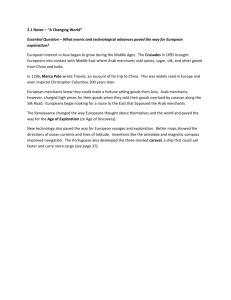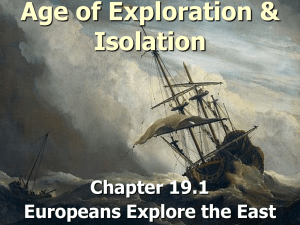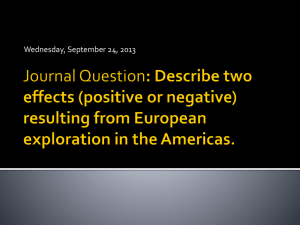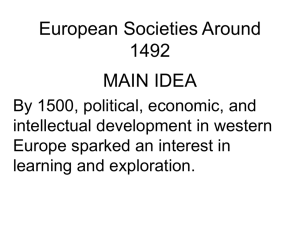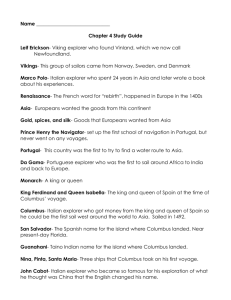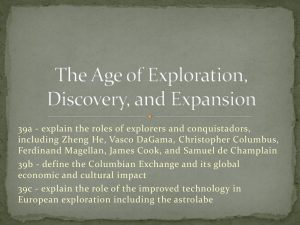The Age of Exploration Test Multiple Choice: Identify the choice that
advertisement
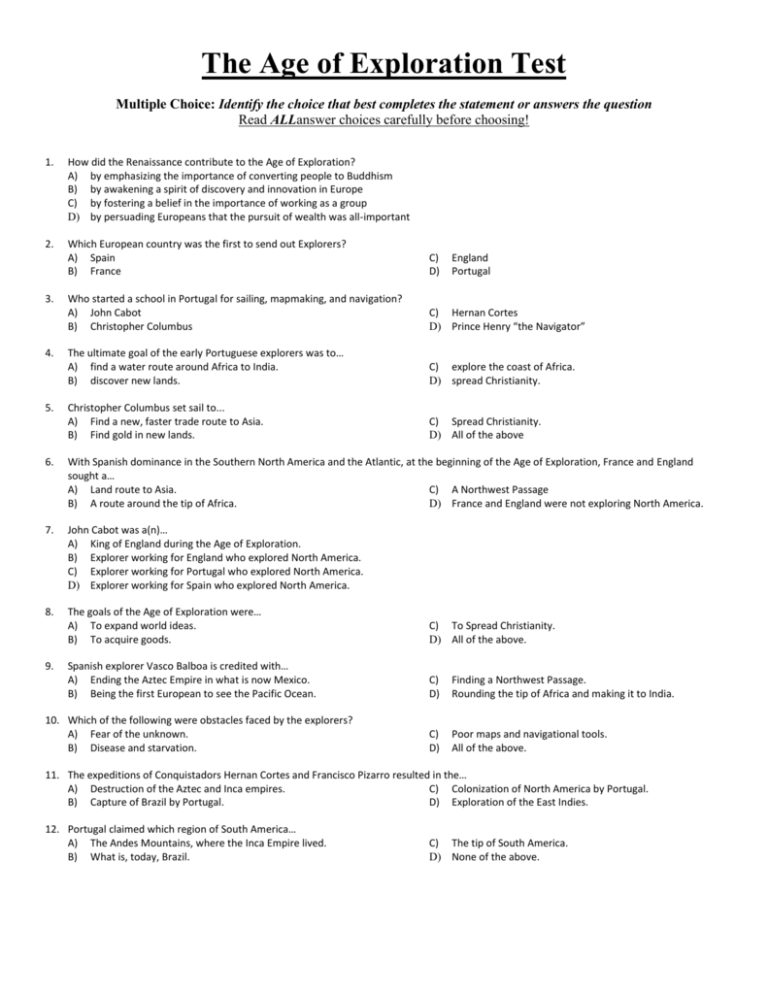
The Age of Exploration Test Multiple Choice: Identify the choice that best completes the statement or answers the question Read ALLanswer choices carefully before choosing! 1. How did the Renaissance contribute to the Age of Exploration? A) by emphasizing the importance of converting people to Buddhism B) by awakening a spirit of discovery and innovation in Europe C) by fostering a belief in the importance of working as a group D) by persuading Europeans that the pursuit of wealth was all-important 2. Which European country was the first to send out Explorers? A) Spain B) France C) D) Who started a school in Portugal for sailing, mapmaking, and navigation? A) John Cabot B) Christopher Columbus C) Hernan Cortes D) Prince Henry “the Navigator” The ultimate goal of the early Portuguese explorers was to… A) find a water route around Africa to India. B) discover new lands. C) explore the coast of Africa. D) spread Christianity. Christopher Columbus set sail to... A) Find a new, faster trade route to Asia. B) Find gold in new lands. C) Spread Christianity. D) All of the above 3. 4. 5. England Portugal 6. With Spanish dominance in the Southern North America and the Atlantic, at the beginning of the Age of Exploration, France and England sought a… A) Land route to Asia. C) A Northwest Passage B) A route around the tip of Africa. D) France and England were not exploring North America. 7. John Cabot was a(n)… A) King of England during the Age of Exploration. B) Explorer working for England who explored North America. C) Explorer working for Portugal who explored North America. D) Explorer working for Spain who explored North America. 8. The goals of the Age of Exploration were… A) To expand world ideas. B) To acquire goods. C) To Spread Christianity. D) All of the above. Spanish explorer Vasco Balboa is credited with… A) Ending the Aztec Empire in what is now Mexico. B) Being the first European to see the Pacific Ocean. C) D) Finding a Northwest Passage. Rounding the tip of Africa and making it to India. C) D) Poor maps and navigational tools. All of the above. 9. 10. Which of the following were obstacles faced by the explorers? A) Fear of the unknown. B) Disease and starvation. 11. The expeditions of Conquistadors Hernan Cortes and Francisco Pizarro resulted in the… A) Destruction of the Aztec and Inca empires. C) Colonization of North America by Portugal. B) Capture of Brazil by Portugal. D) Exploration of the East Indies. 12. Portugal claimed which region of South America… A) The Andes Mountains, where the Inca Empire lived. B) What is, today, Brazil. C) The tip of South America. D) None of the above. 13. Which route on the map above represents Christopher Columbus’s first voyage most accurately? 14. Which route on the map above represents John Cabot’s last voyage most accurately? 15. Which route on the map above represents Vasco da Gama’s voyage most accurately? 16. Which route on the map above represents Magellan’s voyage most accurately? 17. What was the Treaty of Tordesillas? A) The treaty to help end the 100 Years’ War. B) The name given for the route to North America. C) Treaty between Spain and Portugal, giving Spain all land to the West, and Portugal all discovered land to the East. D) The name of Christopher Columbus’ ship at the time of his Atlantic Crossing 18. Silver, during the Age of Exploration was… A) Used as money. B) Used to make navigational tools. 19. Planters in the Americas began to use African slaves for labor because… A) Aztecs refused to work on plantations. B) they believed Native Americans were not human. C) disease had killed millions of Native Americans. D) African slaves were less expensive than Native American slaves. C) D) Mined in colonized regions of America. Both A. and C. 20. According to the map titled “The Slave Trade,” where were most slave forts located? A) The Cape of Good Hope C) The Middle Passage B) The west coast of Africa D) Brazil 21. According to the map titled “The Slave Trade,” the British imported approximately how many slaves to their colonies? A) 1.7 million C) 3.6 million B) 2.1 million D) 9 million 22. According to the map titled “The Slave Trade,” the greatest number of African slaves were taken to… A) British North America C) The British West Indies B) Brazil D) The French West Indies 23. Portuguese explorer Ferdinand Magellan is credited with… A) First person to circumnavigate the world. B) Being the first European to see the Pacific Ocean. C) D) Finding a Northwest Passage. Rounding the tip of Africa and making it to India. 24. The Spanish colonial economy was based largely on… A) exports of Native American weaving and pottery B) tobacco farming C) the mining of gold and silver D) fur and fish trading 25. Before the era of exploration, how did Europeans get goods from Asia? A) Before the explorers, there was no way to get Asian goods in Europe. B) The Ottoman Empire was made up mostly of Chinese and Indian people living in Turkey, so it was easy to get goods. C) Chinese merchants regularly traveled to Europe by traveling through Africa and sailing across the Mediterranean to reach Europe. D) Merchants traveled by horse or camel to Asia and traded with Muslims and Asian territories. 26. What was the Columbian Exchange? A) when the Spanish conquistadors traded their Incan hostages for gold on the border between Columbia and Peru. B) the exchange of plants, animals and disease between the Old World and the New World. C) when Columbus made the first trade of glass beads for gold with the Native Americans. D) the trading of information between European nations after their various voyages of exploration. 27. Which was not a factor behind exploration? A) the invention of the printing press B) spread of religion C) competition with Asian countries for new land D) rise of nation-states 28. Unlike the Spanish and French, the British colonies were populated by… A) men, women, and children from England. B) men only C) women only D) prisoners from England 29. The French colonies that were established in the interior regions of North American from the Appalachian Mountains to the Mississippi River were mostly… A) silver mines B) sugar plantations C) trading posts D) cotton plantations 30. Which of the following was NOT a factor that made Africa vulnerable to the slave trade? A) Politcal fragmentation B) Close to sailing routes C) Availability of people D) Africans wanted to experience the New World 31. In the 17th century, slavery was justified by… A) Pseudo-scientific racism B) The curse of Abraham C) The idea of the “natural” slave D) Some people had bad luck 32. Africans were captured and sold to European slavers by… A) Missionaries B) Native Americans C) Muslim mercenaries D) Other Africans Matching Choose the best description that matches was each explorer did… Vasco Da Gama Ferdinand Magellan Christopher Columbus Prince Henry Hernando Cortes 33. Was given credit as the first explorer to circumnavigate the world. 34. Spanish explorer who conquered the Aztec Empire in Mexico. 35. First explorer to discover “new land” west of Europe and Africa. 36. Set up a navigation school for Portugal. 37. First explorer to find a sea route to Asia by traveling around the coastline of Africa. Short Answer Choose 3 of the 4 questions to answer in a few sentences for each question. a.) What are some positives and negatives from the Age of Exploration? b.) How could the Age of Exploration lead the way for our next lesson of “Age of Revolutions”? c.) Describe the effects of the Columbian Exchange on both the “Old World” and New” World d.) How did Portugal’s accomplishments at the beginning of exploration and their navigation schools help the other European explorers?

